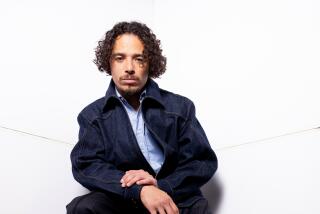Review: ‘Cloud Atlas’ tumbles to Earth
No woman was ever ruined by a book, New York City Mayor Jimmy Walker famously said, but filmmakers are always being seduced by them, with unlucky audiences left to pay the price. The latest case in point is “Cloud Atlas,” which has been turned into a film with muddled, frustrating results.
It’s not difficult to see why the filmmaking Wachowski siblings joined forces with Tom Tykwer to jointly write and direct a version of David Mitchell’s hugely ambitious novel. It’s a book that deals with, as Andy Wachowski has said, “the sum of human experience,” that unabashedly investigates what is important in life.
But the aspects of the story that likely attracted this trio to the creative voyage — not to mention actors such as Tom Hanks, Halle Berry and Jim Broadbent, all in multiple roles — are the very shoals on which cinematic adaptations invariably run aground.
PHOTOS: Who’s who in ‘Cloud Atlas’
Though the novel is rife with incident and drama, its main pleasures have more to do with Mitchell’s exceptional use of language and the book’s delicate, highly unusual structure, neither of which is fated to work as successfully on the screen as on the page.
Not that the filmmakers haven’t labored mightily to solve this problem, or tried awfully hard to make a film that is different and meaningful. Unfortunately, attempts to be original are not enough, they have to succeed, and this film’s solutions tend to present themselves as alternately gimmicky and banal.
The main stumbling block that “Cloud Atlas” presents is not just that its plot consists of six subtly interconnected but wildly different stories that unfold in multiple locations over hundreds of years (though that alone is obviously a major hurdle). Rather, the difficulty is that Mitchell chooses to in effect break the stories in half, telling the first part of each in chronological order and then, at the book’s midpoint, telling the second part in reverse chronology, so that the novel both begins and ends with the same episode.
In chronological order the novel’s stories are:
“The Pacific Journal of Adam Ewing,” in which a young San Francisco attorney makes a life-changing 1849 voyage to a Pacific island where slavery holds sway;
“Letters From Zedelghem,” set in 1936, has a gifted young composer agreeing to work as amanuensis to a terrible tyrant of a Scotland-based older composer;
“Half-Lives: The First Luisa Rey Mystery” takes place in 1973 San Francisco and involves a struggling journalist who comes across a startling story involving nuclear power;
PHOTOS: Who’s who in ‘Cloud Atlas’
“The Ghastly Ordeal of Timothy Cavendish,” the most intentionally comic tale unfolds in 2012 England and involves a dicey publisher whose money problems lead to unforeseen complications;
“An Orison of Sonmi-451” is a science-fiction saga set in 2144 in Neo-Seoul, a high-tech city built after the original was completely flooded, and introduces a genetically engineered restaurant server or fabricant who begins to get ideas above her station;
“Sloosha’s Crossin’ An’ Ev’rythin’ After,” is set in a 24th century post-apocalyptic future (“106 Years After the Big Fall”) and echoes Russell Hoban’s novel “Riddley Walker” in its creation of an invented language for those who have survived the unnamed catastrophe.
MORE: A legend for ‘Cloud Atlas’
It is not a bad idea to commit these story lines to memory, because “Cloud Atlas” is in no hurry to make itself understood. In fact the film opens with a kind of coming attractions trailer that offers tastes of all of the plot strands in such confusing rapid-fire succession that one of the characters actually pleads with us that if we can just be patient for a few minutes, we will be rewarded.
Since telling all these stories the way the book does would not be workable on film, “Cloud Atlas” comes up with a series of stratagems to compensate. All involve making more broad and obvious what was originally subtle and inventive, and all fall short of the mark.
So though “Cloud Atlas” is continually switching from one story line to another over its two-hour and 52 minute length, often for reasons that make sense only to the filmmakers, the film emphasizes the notion that its narrative is in fact one big story playing out over the centuries.
While the dual nature of the filmmaking plan (the Wachowskis directed the 1849 episode and the two futuristic segments, Tykwer the other three) meant separate cinematographers, production and costume designers and makeup crews, the one thing that both units shared was the actors.
So the film’s seven top-billed actors including Hanks, Berry and Broadbent, play either five or six roles apiece, ranging from the small to the substantial, and nine other actors, including Hugh Grant and Susan Sarandon, take on a minimum of three. The notion behind this multi-role playing is that the narrative arc of “Cloud Atlas” is one of the same souls reappearing in different bodies over time in some sort of karmic progression. But though it’s meant to enhance the story’s unity, given all the complex and tricky makeup that is involved, all these switches play more like a distracting gimmick.
The same holds true for the way “Cloud Atlas” blows up themes like the transcendent power of love to the size of Thanksgiving Day parade floats. When one character says “From womb to tomb, we are bound to others, by each crime and every kindness, we birth our future,” she is pushing the film’s theme in a typically relentless way.
Finally, what sinks “Cloud Atlas” is not the largeness of its ambitions but the lack of skill it displays in terms of writing, directing and acting. Earthbound when it wants to be soaring, striving for a kind of profundity that is out of its grasp, this is simply not the film everyone hoped it would be.
---
MPAA rating: R for violence, language, sexuality/nudity and some drug use
Running time: 2 hours, 52 minutes
Playing: In general release
PHOTOS AND MORE:
PHOTOS: Hollywood back lot moments
The Envelope: Awards Insider
PHOTOS: NC-17 movies: Ratings explained
More to Read
Only good movies
Get the Indie Focus newsletter, Mark Olsen's weekly guide to the world of cinema.
You may occasionally receive promotional content from the Los Angeles Times.











